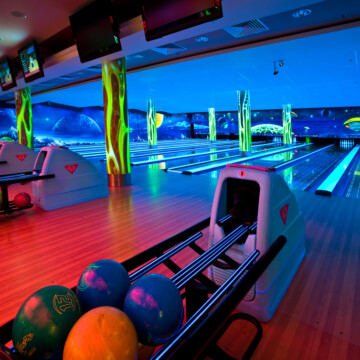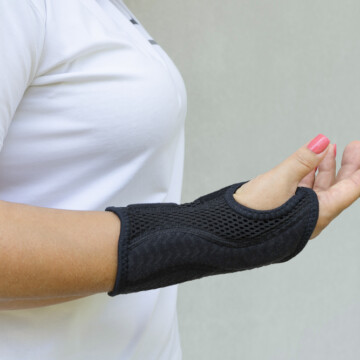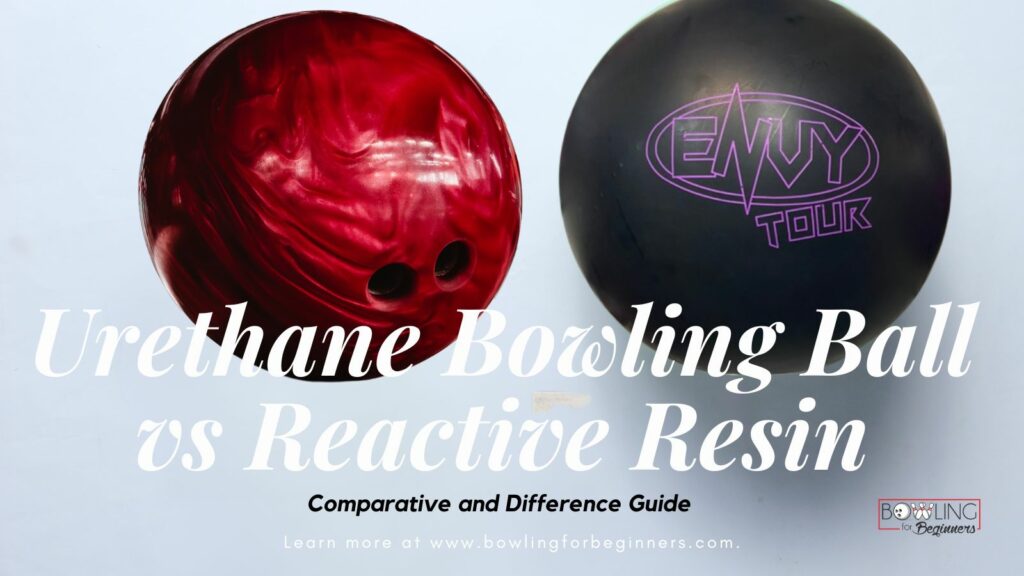
You've been looking to upgrade your bowling ball arsenal. With so many options available, let us clear the air between the two asked about coverstocks: urethane bowling balls vs reactive resin.
Bowling ball coverstocks are made from four different materials. They all react differently in varying degrees with the lane surface, different backend action and hooking potential. In this article, we'll break down the differences between these two types of bowling balls so you can make an informed decision for your next purchase.
Let's get right into it!
Contents
- 1 Urethane Bowling Balls vs Reactive Resin
- 1.1 Key Takeaways
- 1.2 What Is Urethane?
- 1.3 Urethane Ball Characteristics
- 1.4 Benefits of Using Urethane Bowling Balls
- 1.5 Drawbacks of Urethane Bowling Balls
- 1.6 What Is Reactive Resin?
- 1.7 Characteristics of Reactive Resin Bowling Balls
- 1.8 Benefits of Reactive Resin Bowling Balls
- 1.9 Drawbacks of Reactive Resin Bowling Balls
- 2 What Is the Difference Between Reactive Resin and Urethane Bowling Balls?
- 3 Similarities Between Urethane and Reactive Resin Bowling Balls
- 3.1 Purpose
- 3.2 Skill Level Variability
- 3.3 Scoring Potential
- 3.4 Lane Adjustments
- 3.5 Price Range
- 3.6 Why Don’t People Like Urethane Bowling Balls?
- 3.7 Are They Banning Urethane Bowling Balls?
- 3.8 Maintenance Tips for Urethane and Reactive Resin Balls
- 3.9 When to Use Urethane Bowling Balls vs Reactive Resin Bowling Balls
- 3.10 Choosing the Right Weight for Your Bowling Ball
- 3.11 Which Ball Type Is Best for You?
- 3.12 Related Articles
Urethane Bowling Balls vs Reactive Resin
Filling your arsenal with the right balls is a great way to improve your game and adapt to different lane conditions. When it comes to selecting types of bowling balls, two popular options are urethane bowling balls and reactive balls.
- Urethane Balls: Introduced in the 1980s, feature durability, versatility, and slight hook potential.
- Reactive Resin Balls: A blend of urethane and reactive materials, offer increased friction and hook potential.
- Primary Use: Urethane is used on dry lanes for straight shots. Reactive resin is used on oily lanes for powerful shots.
Key Takeaways
- Urethane vs. Reactive Resin: Urethane balls have a smoother hook for dry lanes. Reactive resin balls have a stronger hook for oily lanes.
- Durability and Price: Urethane balls are more durable and cheaper. Reactive resin balls have higher performance but are more expensive.
- Skill Level Suitability: Beginners and those who prefer straight shots benefit from Urethane balls. Advanced bowlers choose reactive resin balls for their strong hook potential.
- Maintenance Requirements: Reactive resin balls require a different level of cleaning because they're more porous. Urethane balls do not require the same level of maintenance.
- Lane Condition Adaptability: Urethane balls work well on drier lanes and for spare shots. Reactive resin balls are great on oily lanes and for powerful strikes.
What Is Urethane?
Urethane is a type of plastic material that is commonly used in bowling balls. It was originally introduced to the bowling market in the 1980s and quickly gained popularity due to its durability, versatility, and slight hooking potential.
Urethane Ball Characteristics
Similar to plastic bowling balls, urethane balls have a smooth surface and a low friction coefficient, meaning they don't have a ton of grip on the lane. This results in a more controllable/less aggressive hook motion, making them ideal for bowlers who prefer a straighter shot (though not completely straight) or need to navigate dry lanes.
Benefits of Using Urethane Bowling Balls
Some of the main benefits of using urethane bowling balls include their durability, versatility, and affordability. Urethane balls tend to have a longer lifespan compared to other bowling balls, making them a great investment for bowlers who are looking for a ball that will last.
Reactive resin balls offer the ability to work well on various lane conditions, from light oil to medium oil patterns. Plus, due to their predictability, many bowlers like to use urethane balls for picking up spares, especially when precision is needed.
Drawbacks of Urethane Bowling Balls
Urethane bowling balls aren't without drawbacks. First, they're not necessarily the best choice for complete beginners who might not yet have the control and technique to take advantage of their features.
In addition, they're not the best choice for heavily oiled lanes. The ball's surface doesn't cut through oil as effectively as some other materials might, reducing its effectiveness on oily lane conditions. If you want more friction or hooking power, urethane bowling balls won't give that to you. Keep reading for the type of ball that does.
- Benefits: These bowling balls are strong, flexible, and affordable. They are great for dry lanes and spare shots.
- Drawbacks: This bowling ball doesn't work well on very oily lanes. It's not recommended for beginners who struggle with control and technique.
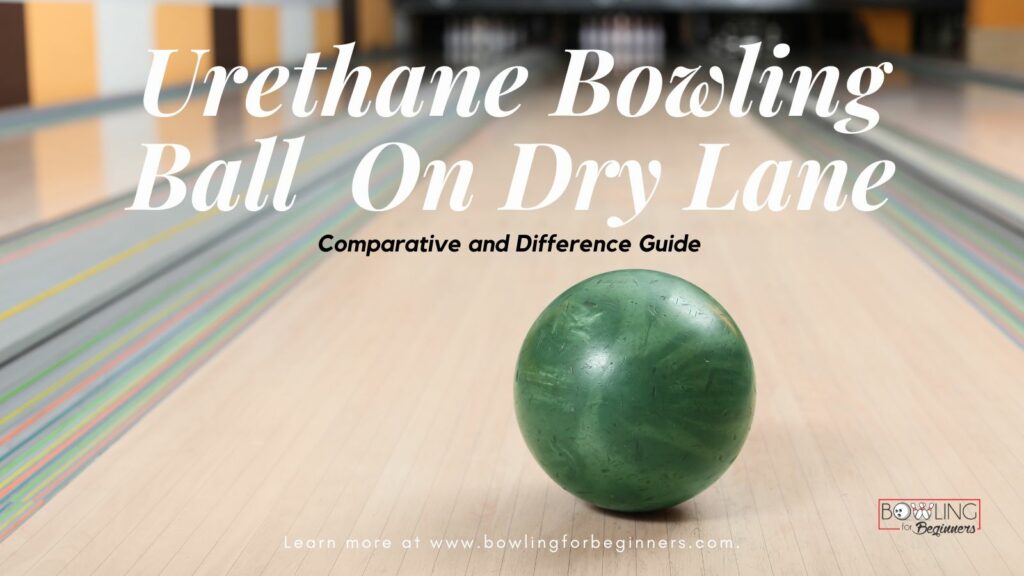
What Is Reactive Resin?
Reactive resin is a bowling ball coverstock material that has gained popularity in recent years. It is made up of urethane and reactive materials such as particles of resin or ceramics.
This combination creates a ball with enhanced or increased friction on the lane, resulting in increased hook potential and overall performance. It's not like the free house balls at your local bowling alley.
Characteristics of Reactive Resin Bowling Balls
Unlike plastic balls and urethane balls, reactive resin balls have a high friction coefficient and a textured surface, providing more traction (teeth) on the bowling lane. This results in higher hook potential and better pin carry, making them an excellent choice for bowlers looking for more power in their shots.
- Surface and Friction: High friction coefficient with a textured surface for enhanced traction.
- Lane Performance: Excels on oily lanes with a high hook potential and better pin carry.
- Bowler Suitability: These balls are popular with skilled bowlers because they curve a lot and score well.
Benefits of Reactive Resin Bowling Balls
The main advantage of using reactive bowling balls is their ability to create a strong angular motion on the lanes. This allows for more pin action and increases your chance of nailing those strikes. These balls are designed to perform well even on oily lanes.
What's more, reactive resin balls come in different configurations and can be suited to various lane conditions and bowler preferences. Whether you want a skid-snap reaction or a more even arc, there's likely a reactive ball that fits the bill. They can handle heavy oil patterns extremely well.
And for those who are looking to increase their bowling average, reactive resin balls often offer higher scoring potential. Intermediate and advanced bowlers/professional bowlers often use them for this reason.
Drawbacks of Reactive Resin Bowling Balls
Reactive resin bowling balls are not going to be the best choice for every bowler or lane condition. For starters, they're not ideal for those just starting out in the sport, as reactive resin's aggressive nature can be harder to control and may result in unpredictable shots.
Even if your ball is an absolute stunner with a mean hook and crazy power, you won't be able to do much with a reactive resin unless you have developed the necessary skills. Developing the needed skills require regular practice, that you stick with. This is why reactive resin isn't for everyone; only a few bowlers can properly manage it.
These balls also tend to wear out faster than other types of bowling balls due to their porous coverstocks combined with the high lane friction they create. This means they will need to be maintained and replaced more frequently, which can be costly.
Speaking of cost, a reactive resin ball will generally be more expensive than other types of bowling balls. This is due to their advanced technology and performance capabilities.
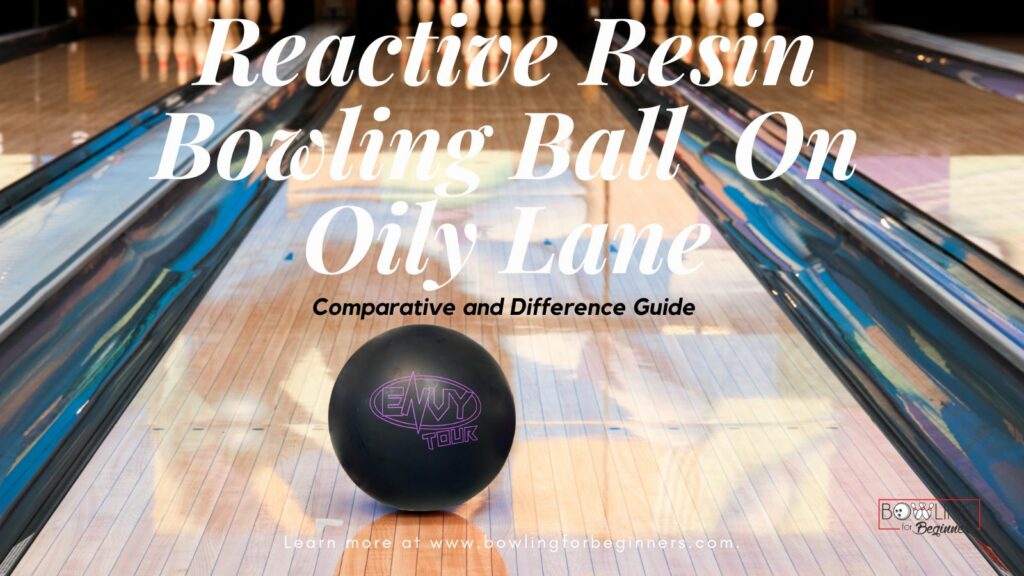
What Is the Difference Between Reactive Resin and Urethane Bowling Balls?
There's no single difference between reactive resin and urethane bowling balls - there are several. And we'll share each of them with you in the section below:
Material Composition
Reactive resin balls are crafted with a porous coverstock that allows for better friction between the ball and the lane. This higher friction allows the ball to grip the lane better, particularly in the oil, giving it a more aggressive hooking action.
On the other hand, urethane balls have a smoother surface, which leads to a more controlled and predictable roll. The surface properties directly contribute to how the ball behaves on the lane, affecting everything from hook potential to pin action.
Hook Potential
When it comes to hooking ability, reactive resin balls take the cake. They're designed for a stronger backend reaction and angular hook, leading to significant pin action. Urethane balls, however, offer a smoother, more controlled hook that starts earlier on the lane.
This results in a less dramatic backend reaction but adds an element of control that some bowlers find advantageous.

Lane Condition Suitability
Reactive resin balls are generally suited for a specific pattern of oil. These oil patterns are heavily oiled. Reactive Resin's porous surface allows them to cut through the heavy oil, leading to a more pronounced hook. Urethane balls are usually better on drier lanes, where their controlled, less aggressive hook can be a significant advantage.
Understanding the lane conditions you'll most often be playing on can help you make an informed decision between the two.
Control and Predictability
Urethane balls win out in terms of control and predictability. Their smoother surface and earlier hook make them easier to control, which is particularly beneficial on drier lanes or when precision is required.
Reactive resin balls, while offering more aggressive hook potential, can be more unpredictable, especially for those not accustomed to adjusting for different lane conditions.
Maintenance
Reactive resin balls require a bit more TLC (tender loving care) when it comes to maintenance. Because they are more porous and absorb more lane oil, they need to be cleaned more frequently to maintain optimal performance.
Urethane balls, being less porous, are generally easier to maintain and have a longer effective lifespan, making them a good choice for those who'd rather not spend too much time on ball upkeep.
Skill Level
Reactive resin balls are often the go-to choice for advanced bowlers who can harness their aggressive hooking potential. These balls require a good understanding of lane conditions and hook dynamics to be used effectively.
Urethane balls, on the other hand, are more forgiving and can be a solid choice for those focusing on control and straighter shots, including bowlers who are still honing their skills.
Price Point
While both types of balls come in a variety of price ranges, high-performance reactive resin balls can be on the more expensive side. These balls often feature specialized cores and coverstocks designed for specific lane conditions or types of hooks.
Urethane balls are generally available at various price points, but high-quality options can also come with a significant price tag (though often more affordable than reactive resin balls).
Versatility
Reactive resin balls can be sensitive to changing lane conditions, often requiring the bowler to adjust their approach and strategy as the game progresses. Urethane balls offer a more consistent performance across various lane conditions, adding an element of versatility to your game that can be advantageous in different bowling scenarios.
Spare Shooting
Lastly, when it comes to making spare shots, the predictability of a urethane ball often makes it the preferred choice. Its smoother, controlled action can be an asset when you need to hit specific pins. Reactive resin balls, with their more pronounced hook, may not always be the best option for shooting spares unless you're adept at controlling their more aggressive movement.
Similarities Between Urethane and Reactive Resin Bowling Balls
The differences between urethane and reactive resin bowling balls are plenty, but they do have some similarities. We'll explore them below:
Purpose
Both urethane and reactive resin balls are designed with the intent to offer bowlers a tool for hooking, curving, or otherwise controlling the ball's movement down the lane. While the degree of the hook may differ, the underlying objective is the same: to knock down pins more effectively than with a straight shot.
Skill Level Variability
Both urethane and reactive resin balls come in a variety of styles and designs to accommodate bowlers of different skill levels. Whether you're a beginner, intermediate, or advanced bowler, there are options available in both materials to suit your game.
Scoring Potential
When used effectively, both types of balls have the potential to deliver high-scoring games. Both can be used for strikes and spares, and both can be fine-tuned in terms of speed, spin, and angle to maximize scoring potential.
Lane Adjustments
For both reactive resin and urethane balls, bowlers need to be mindful of lane conditions and may have to adjust their throw mechanics, such as release point and speed, depending on the oil pattern and its breakdown over time. Neither type of ball is going to work for you all the time - you need to note the lane conditions and adjust on the fly based on your strategy.
Price Range
Both reactive resin and urethane balls come in a broad price range, offering options for bowlers on various budgets. Whether you're looking for a budget-friendly option or willing to invest in a high-performance ball, both categories have something to offer.
Note: Still, reactive resin balls tend to cost a little more than urethane balls in many cases.
Why Don’t People Like Urethane Bowling Balls?
The pre-2020 coverstocks were too hard, the balls failed pre-tournament hardness checks, and many people found them hard to control.
In addition, a notable issue is that urethane balls tend to push oil down the lane, creating a condition known as "oil carry down."
This can alter the lane conditions and potentially "ruin the shot" for subsequent players by making the lane more challenging to read and adjust to. This carry down effect can be particularly frustrating in team play or league settings, where consistent lane conditions are conducive to smoother play.
Are They Banning Urethane Bowling Balls?
The Professional Bowlers Association (PBA) has banned urethane bowling balls as of March 2022.
The reason for this is that older ones (prior to 2020) do not meet the hardness specification set by the USBC. As per new regulations, balls are not allowed to have a lower hardness rate than 72D.
However, many newer urethane balls meet these criteria and are still allowed for use in PBA tournaments. Urethane balls also remain popular among amateur bowlers and are widely used in recreational play. Ultimately, it is up to individual bowling establishments to determine their rules and regulations regarding ball usage.
Maintenance Tips for Urethane and Reactive Resin Balls
Keep them clean after each use, store them in a dry and cool place, and resurface as needed.
To maintain your urethane or reactive resin bowling balls, it's important to keep them clean (as often as after every use). This will help remove any accumulated oil and dirt from the surface of the ball and ensure consistent performance.
It is also advisable to store these types of bowling balls in a cool and dry place, away from extreme temperatures.
Resurfacing your urethane or reactive resin balls may also be necessary to maintain their optimal performance or fine-tune their reaction on the lanes. This process involves sanding down the surface of the ball to remove any scratches or dents and restore its original smoothness. It is recommended to have this done by a professional at a pro shop.
When to Use Urethane Bowling Balls vs Reactive Resin Bowling Balls
The decision to use a urethane or reactive resin bowling ball depends on several factors, but start with the most obvious ones: the lane conditions and personal preference.
Urethane balls are typically used on dry to medium lanes, where they can provide a smooth and controlled hook motion.
Reactive resin balls are better suited for medium to heavy oil patterns, as they offer stronger backend reactions.
Your personal preference for your hook shots will also determine which bowling ball is used. Remember, reactive resin balls are going to give you much more hook potential than urethane balls. But you’ll need quite a bit of experience and ball control to use it to your advantage.
Choosing the Right Weight for Your Bowling Ball
Your bowling ball should be comfortable to lift and throw repeatedly through all 10 frames for multiple games.
The weight of your bowling ball should be 10% of your body weight.
Many bowlers make the mistake of choosing a heavier ball in hopes of increasing their power, but this often leads to poor form and an inconsistent release.
Which Ball Type Is Best for You?
The best bowling ball for you will depend on your skill level, playing style, and lane conditions.
If you want to experiment with strong hooks, you may prefer reactive bowling balls. If you prefer a more consistent and controllable hook, go with a urethane bowling ball. If you're a beginner or have limited experience, start with a urethane ball or a plastic ball.
Look for a ball with a weight that you can comfortably handle and control. Consider getting your ball professionally drilled to fit your hand for maximum comfort and control.
It's worth experimenting with different types of balls to find the one that feels right and gives you the best results.
Related Articles

Bowling balls made of different coverstock materials are better for different lanes and bowlers. Urethane balls are durable and easy to control. They work well for straight shots and on dry lanes.
Beginners and those who want a predictable hook motion will find them suitable. Skilled bowlers like reactive resin balls because they hook well on oily lanes.
Urethane balls need less maintenance. Resin balls need regular cleaning because they absorb dirt. To choose the best ball, consider your skill level, playing style, and lane conditions. Both types have advantages that can make a huge difference in your game, whether you want control or power.
Kira Byrd, a Certified Fraud Examiner, holds a B.S. in Accounting from the University of Alabama at Birmingham. With a passion for bowling from her childhood, Kira has poured her expertise and personal experiences into creating and nurturing Bowling For Beginners. Kira's mission is to meet new bowlers where they are and guide them toward consistently achieving higher scores. With a focus on skill development and strategic techniques, she empowers readers to take control of their game and unlock their true potential.
Bowling For Beginners embodies strict editorial integrity, ensuring reliable and unbiased information. Kira's commitment to delivering valuable insights and practical strategies is reflected in every article. Here's an explanation of our editorial policy and how we get money.




